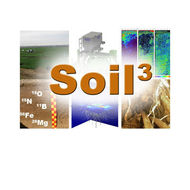A century of liming affects the Mg isotopic composition of the soil and crops in a long‐term agricultural field at Berlin‐Dahlem, Germany (2021)
Wang Y., Wu B., Berns A., Bol R., Wombacher F., Ellmer F., Amelung W.
European Journal of Soil Science, 72 (1), 300-312
Abstract
Liming is widely used to alleviate soil acidity in western and central Europe, but its role in the cycling of magnesium (Mg) in arable soil–plant systems is still ambiguous. Here, we systematically analysed Mg concentrations and the natural Mg stable isotope compositions (δ26Mg) of two Mg pools in soil profiles and a major crop (winter rye) in a long‐term German agricultural experimental field that has been managed with and without liming since 1923. The results showed that the δ26Mg signatures of the bulk soil Mg pool in the studied Albic Luvisol displayed limited variation with depth and between the liming treatments. In contrast, the exchangeable soil Mg pool exhibited an increase in δ26Mg values with depth down to 50 cm, which was more pronounced in the limed plots. We attributed this enrichment of light Mg isotopes in upper layers to the Mg addition from “Dolokorn 90” lime, as well as to the removal of heavy Mg isotopes by plant uptake. The subsequent use of a simple isotope‐mixing model suggested that only 25% of the remaining Mg in the soil exchangeable pool stemmed from the last liming practice. The other parts of the exchangeable soil Mg pool had either interacted with the bulk soil matrix or had been utilized by the plants. Almost 100 years of liming enhanced Mg uptake by the vegetation, probably via elevated Mg contents in the grain, and reflected by the stronger depletion of heavy Mg isotopes in the soil exchangeable Mg pool relative to non‐limed plots. Whole winter rye plants were enriched in heavy Mg isotopes but they displayed similar Mg isotope compositions among plant organs in all plots, indicating identical Mg uptake and translocation strategies in the different trials. Tracing the stable isotope compositions of soil and plant Mg thus opens novel opportunities to evaluate soil management impacts on the cycling and fate of this essential nutrient in agricultural systems.

